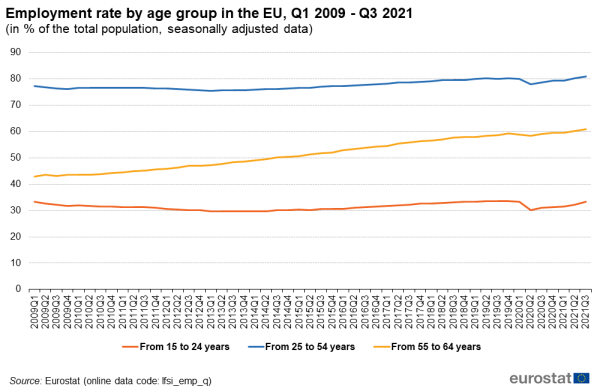Archive:Employment - quarterly statistics
Data extracted in March 2022
Planned article update: July 2022
Highlights
The third quarter of 2021 marked an important phase in the recovery of the European economy and labour market. This is the beginning of the general reduction of distancing measures generated by the health crisis due to the COVID-19 pandemic. Many EU Member States announced the end, partially or entirely, of financial assistance to businesses to mitigate the negative effects of the COVID-19 crisis on employment and businesses. In the second quarter, the rebound of the economy was initiated and clearly visible in the development of employment in comparison with the first quarter of 2021.
This article gives an overview of employment at EU level, as well as at national level in the individual Member States, three EFTA countries (Iceland, Norway and Switzerland) and one candidate country (Serbia), focusing on the two first quarters of 2021. The results come from the European Union Labour Force Survey (EU-LFS). It also provides, for the first time, an insight into the quarterly results collected on the employment of the first and second generations of migrants. Furthermore, this article depicts employment in general and specifically by gender, age and level of educational attainment. A complementary analysis in this article focuses on temporary contracts and part-time work in the second quarter of 2021. This article ends with an overview of the employment of the first and second generation of migrants based on a new set of quarterly indicators.
This article is part of the publication Labour market in the light of the COVID-19 pandemic.
Note: Please note that figures presented in this article may differ in some cases from the source data due to continuous revision of the Eurostat database (Employment and unemployment (Labour Force Survey)).
Full article
Main facts in Q3 2021
In the third quarter of 2021, the share of employed people in the total population aged 20 to 64 in the EU reached 73.6 %. In the Netherlands, Sweden, Germany and Czechia, more than 8 in 10 people aged 20 to 64 were employed, the employment rates amounted respectively to 82.7 %, 81.0 %, 80.4 % and 80.2 % while the share of employed people stood below 70 % in Italy and Greece (both with 63.3 %), Romania (67.3 %), Croatia (67.9 %) and Spain (68.0 %).
The total employment rate masks a significant difference between men and women. While 79.0 % of men aged 20-64 were employed, the employment rate of women was 68.3 %. Therefore, the gender gap was 10.7 p.p. in the third quarter of 2021. Figure 1 shows that the employment rates varies across the EU, firstly between countries and secondly between men and women in many EU Member States.
In all EU Member States, the share of employed men was higher than the share of employed women. Although the three widest gender gaps in employment are observed among countries with the lowest employment rates, this relationship between both is not seen in all countries. The largest differences between the employment rate of men and women were found in Romania, Italy, Greece and Malta, all showing a gender gap of 18 percentage points (p.p.). In contrast, Finland, Lithuania, Estonia, Sweden and Latvia recorded the narrowest gaps between men and women, all below 5 p.p. Czechia, Malta and the Netherlands reported the highest employment rates of men with respectively 87.4 %, 87.0 % and 86.4 % while the highest female employment rates in the third quarter of 2021 were 79.0 % in Netherlands, 78.7 % in Sweden and 77.8 % in Lithuania.
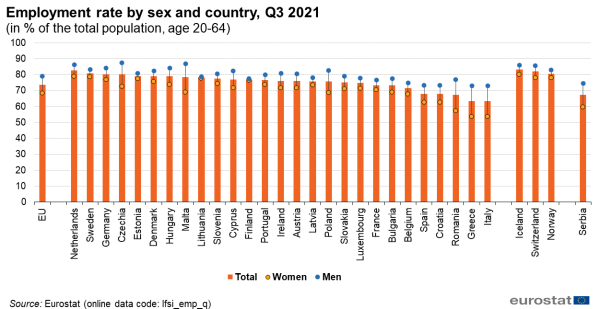
(in % of the total population, age 20-64)
Source: Eurostat (lfsi_emp_q)
Most countries above the pre-COVID employment rate
In the EU, employment recovered the pre-COVID situation in most countries
In the EU, the COVID-19 pandemic strongly hit the employment in the second quarter of Q2 2020. At EU level, the employment rate decreased by 2.2 percentage points (p.p.) from the quarter before the start of the pandemic (i.e. Q4 2019) to Q2 2020 and in all EU Member States, the employment of people aged 20-64 stepped back, see Figure 2A. The largest decreases were recorded in Greece (-7.7 p.p.), Ireland (-5.9 p.p.) and Spain (-4.8 p.p.). In Austria, Estonia and Italy, the employment ratealso changed significantly but to a lesser extent, from -4.0 p.p. to -3.0 p.p. By contrast, the Netherlands, Czechia, Slovakia, Hungary, Latvia, Denmark and Croatia were also affected but the employment rate dropped by less than 1 p.p. over the same period.
Looking at Figure 2B that compares the pre-COVID level to the situation in Q3 2021, it is clearly visible that in most countries and also at EU level, the employment rate of people aged 20-64 in Q3 2021 exceeded the employment rate recorded in Q4 2019. In fact, at EU level, the employment rate reached 73.6 % in Q3 2021 against 72.9 % in Q4 2019. A positive change was also recorded in 17 out of 27 EU Member States. The largest progressions were found in Poland (+3.0 p.p.) and Slovenia (+2.1 p.p.). Nevertheless, increases lower than 2 p.p. but higher than 1 p.p. were reported by Luxembourg, Greece, the Netherlands, Romania, Hungary, Malta, Cyprus and Portugal. On the other end, nine countries lagged behind and are still below the pre-COVID level of employment. In particular, Estonia and Latvia for which the employment rate is respectively 2.2 p.p. and 1.6 p.p. lower than in Q4 2019. Austria, Bulgaria, Italy, Sweden, Spain, Slovakia and Czechia had not reached yet either their pre-COVID level of employment but the difference is lower than 1 p.p. Lithuania is the only country showing the same employment rate in both quarters.
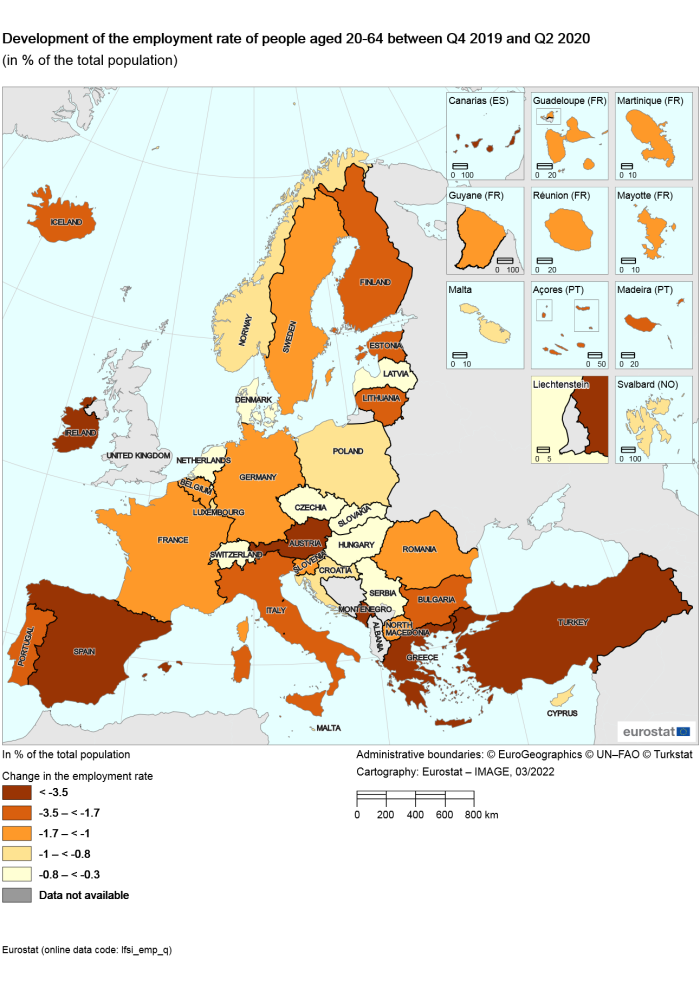
(in % of the total population, seasonally adjusted data)
Source: Eurostat (lfsi_emp_q)
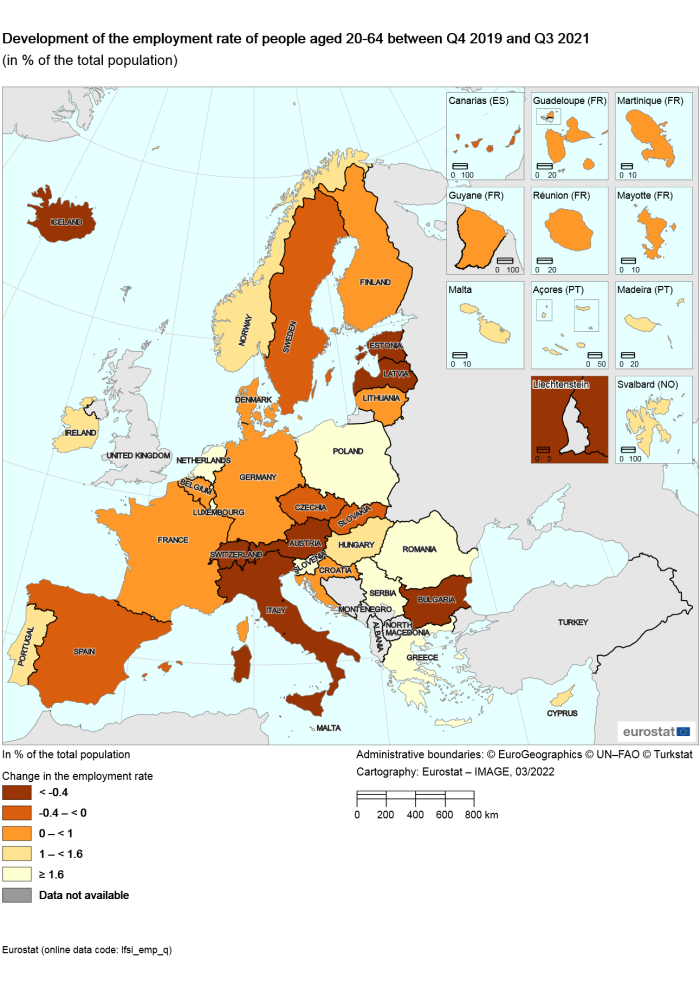
(in % of the total population, seasonally adjusted data)
Source: Eurostat (lfsi_emp_q)
Employment increased in 25 out of 27 EU Member States from Q1 2021 to Q2 2021
In order to provide an overview of employment at national level, Figure 2 presents the employment rate of people aged 20 to 64 by country and sex in the second quarter of 2021. This figure clearly shows that the employment rates are not homogeneous across the EU, firstly between countries and secondly between men and women in many EU Member States. In the Netherlands and in Sweden, more than 8 in 10 people aged 20 to 64 were employed (82.0 % and 80.8 %, respectively) while the share of employed people stood below 70 % in Greece (61.2 %), Italy (62.0 %), Romania (66.8 %), Spain (67.2 %) and Croatia (67.8 %).
From the first to the second quarter of 2021, the highest increases were reported in Slovenia (+2.8 p.p.), Greece (+2.1 p.p.), Belgium and Luxembourg (both +1.5 p.p.). Substantial increases, of more than 1 p.p., were found in Sweden, Finland, Portugal and Ireland. The share of employed people also increased in France, Cyprus, Czechia, Bulgaria and Austria but to a lesser extent: the increases in these countries did not exceed 0.5 p.p. Only in two EU Member States (i.e. Estonia and Romania), the employment rate decreased from the first to the second quarter of 2021 (-1.4 p.p. and -0.3 p.p.).
The highest employment rate registered among men in Czechia
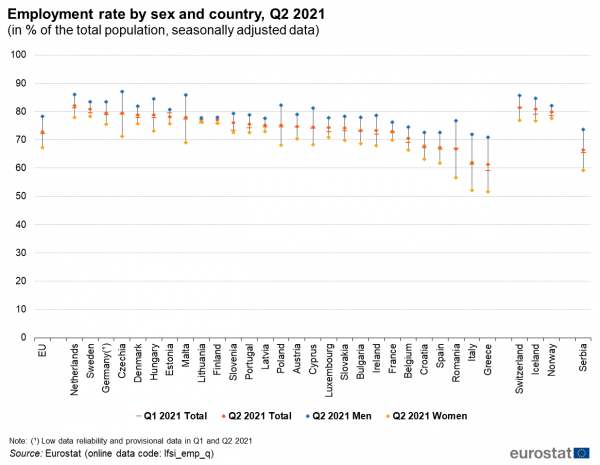
(in % of the total population aged 20-64, seasonally adjusted data)
Source: Eurostat (lfsi_emp_q)
Record high in the employment rate except for young people
In Q3 2021, at EU level, one third (33.3 %) of young people aged 15-24 were employed. During the same quarter, this share was 80.9 % for people aged 25-54 and 61.0 % for those aged 55-64. Moreover, in Q3 2021, people aged 25-54 and 55-64 recorded their highest employment rate for the whole period since Q1 2009 (see Figure XX). The senior age group (55-64) had the largest increase in employment rate from Q1 2009 to Q3 2021, amounting to 18.0 percentage points. Over the same period, the employment rate for people aged 25-54 (+3.6 p.p.) increased to a lesser extent and slightly decreased for people aged 15-24 (-0.1 p.p.).
From Q3 2015 to Q4 2019, the employment rate increased or remain stable in every quarter for the three age groups shown in Figure XX. The only slight exception was in Q3 2019 when the employment rate for people aged 25-54 decreased by 0.1 p.p. This trend changed after Q4 2019 due to the outbreak of the COVID-19 pandemic. From Q4 2019 to Q2 2020, the employment rate for young people decreased the most significantly, with 3.4 p.p. Over the same period, the employment for people aged 25-54 decreased by 2.3 p.p. while it decreased by 0.8 p.p. for those aged 55-64. Furthermore, the employment rate for people aged 55-64 returned to and exceeded its pre-pandemic level from Q4 2019 already in Q4 2020 and continued to increase during every quarter until Q3 2021. At the same time, after its significant drop from Q4 2019 to Q2 2020, the employment for people aged 25-54 returned at the same level as in Q4 2019 only in Q2 2021 and also increased in the following Q3 2021. Finally, the employment rate for young people did not recover its levels after the decline in 2020, although it began to approach the pre-pandemic value of Q4 2019.
Comparing the EU countries the largest disparities in employment rate were recorded for young people aged 15-24 (see Figure XX). In Denmark (54.5 %), Austria (51.8 %) and Malta (50.7 %), over half of the population aged 15-24 was employed in Q3 2021. This proportion reached even 73.5 % in the Netherlands. At the other end of the scale, employed were less than one-fifth of young people in Italy (17.9 %), Bulgaria (16.2 %) and Greece (14.0 %).
Shifting the focus on the other age groups, Slovenia (89.3 %), Hungary (87.2 %) and the Netherlands (87.1 %) recorded the highest employment rates for people aged 25-54, while Spain (75.7 %), Greece (72.4 %) and Italy (70.6 %) the lowest. The employment rate for the seniors (aged 55-64) was the highest in Sweden (76.8 %), Estonia (73.8 %) and Germany (72.8 %), while the lowest rate for this age group was found in Greece (49.4 %), Luxembourg (44.3 %) and Romania (43.5 %).
In all countries the employment rate for people aged 25-54 was higher than for people aged 55-64, which was higher than those for people aged 15-24. The Netherlands was an exception with higher employment for young people (aged 15-24) than for those aged 55-64.
EU countries also show significant disparities when looking at the quarterly change from the pre-pandemic Q4 2019 to Q3 2021 for the different age groups (see Figure XX). The development in employment for young people (aged 15-24) varied the most, ranging from an increase of more than 4 p.p. in Luxembourg, Ireland and Slovenia to a decrease of more than 4 p.p. in Poland, Estonia, Bulgaria and Latvia. Most of the EU Member States (16 countries) had a lower employment rate in Q3 2021 than in Q4 2019, considering people aged 15-24. Variations in the change between Q4 2019 and Q3 2021 for people aged 25-54 were less prominent, ranging from a 3.1 increase in Poland to a 2.1 decrease in Estonia. Fewer countries had an employment rate in Q3 2021 below the level of Q4 2019 for this age bracket, 12 in total. The development between Q4 2019 and Q3 2021 was quite different for people aged 55-64 as only Italy and Malta recorded slightly lower employment rates for this age group in Q3 2021 than in Q4 2019 (change of less than 1 p.p.). All other countries recorded an increase in the employment rate for people aged 55-64 over the same period; moreover, this increase exceeded 5 p.p. in Croatia, Poland, Greece and Hungary.
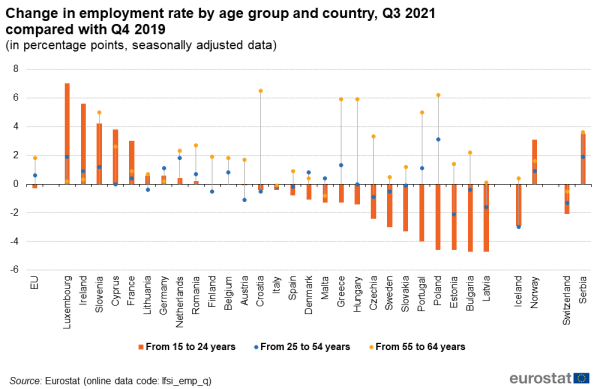
Source: Eurostat (lfsi_emp_q)
Disparate employment rates for men and women with low, medium and high educational attainment level
The employment evolution by sex and educational attainment level over the period Q1 2009 - Q3 2021 shows noticeable differences, both for men and women (aged 20-64), according to their level of educational attainment (see Figure XX). The employment rate of men with a high educational level (i.e. tertiary education) is always higher than the employment rate of men with a medium (i.e. at most upper secondary or post-secondary non-tertiary education) or low educational level (i.e. less than primary, primary or lower secondary education, at most). This was also the case for women. In the same way, people with a medium educational level are proportionately more employed than people with a low educational level.
Another relevant finding is that the lower the educational attainment level, the wider the gap between the employment rates of men and women. This is true for the whole data series shown in Figure XX. The gender employment gap decreased over the period from Q1 2009 to Q3 2021: from 23.2 p.p. to 21.9 p.p. for people with low education, from 12.4 p.p. to 11.7 p.p. for the people with medium and from 6.2 p.p. to 5.2 p.p. for those with a high level of education.

Source: Eurostat (lfsi_educ_q)
After Q4 2019, due to the onset of the COVID-19, the employment rate started a downward trend, reaching its lowest levels in Q2 2020. This can be seen for both genders and three levels of education (low, medium and high). Women with medium (-3.1 p.p.) and men with a low level of education (-2.6 p.p.) had the most substantial decreases in employment from Q4 2019 to Q2 2020. Following the significant drop in Q2 2020, the employment rate began to recover. However, it could not reach its pre-pandemic levels from Q4 2019 up until Q2 2021. In Q3 2021, some groups had a slightly higher employment rate than in Q4 2019, namely men with low (+0.3 p.p.) and medium education (+0.1 p.p.), also women with medium (+0.2 p.p.) and high education (+0.5 p.p.). At the same time, in Q3 2021, men with a high level of education had the same employment rate as in Q4 2019, and women with a low level of education had still an employment rate, which was lower than before the pandemic (-0.2 p.p. compared with Q4 2019).
Prevalence of temporary contracts among young employed people, part-time among women
Nearly one quarter of employed people in Spain and in the Netherlands had a temporary contract in Q2 2021
One relevant finding in the second quarter of 2021 refers to the share of temporary contracts (see Figure 5). Temporary contracts accounted for 13.0 % of employees in the EU. This share reached 24.7 % in Spain and 23.1 % in the Netherlands which means that almost 1 in 4 employees aged 20-64 were employed with a temporary contract in these two countries. The lowest shares were observed in Estonia (1.7 %), Lithuania (1.9 %), Romania and Latvia (both 2.4 %), Bulgaria (3.2 %) and in Slovakia (3.7 %). No clear link is visible between the level of employment and the share of temporary contracts in a country (see the attached Excel file for further details).

(in % of total employees aged 20-64, seasonally adjusted data)
Source: Eurostat (lfsi_pt_q)
However, the disparity between the different age groups is very high. Almost 1 in 2 employees aged 15 to 24 (49.0 %) had a temporary contract, 11.9 % for people aged 25 to 54 and 6.3 % for people aged 55 to 64. Furthermore, the latest quarterly results show that the share of temporary contracts among young people (aged 15-24) is quite specific across countries. For example, it equals or exceeds 60 % in Spain, which recorded the highest share with 69.4 %, the Netherlands (66.6 %), Slovenia (64.7 %), Italy (61.7 %) and Portugal (60.0 %) while temporary contracts amounted to less than 15 % in Bulgaria (8.5 %), Lithuania (8.7 %), Romania (8.8 %), Hungary (13.2 %), Slovakia (13.5 %) and Malta (14.7 %).

(in % of total employees, seasonally adjusted data)
Source: Eurostat (lfsi_pt_q)
Around than 1 in 4 men working part-time would like to work more, this share drops to less than 1 in 6 among women working part-time
In all EU countries, more women than men tended to work part-time, Romania was the only exception. In the EU, 28.3 % of employed women worked part-time but only 7.5 % of men in Q3 2021. 15.2 % of women working part-time wanted to work more hours while this percentage was 24.7 % for part-time working men. Figure XX shows the share of men and women working part-time as well as the share of underemployed part-time workers in the total male and female employment. For women, the highest shares of employed women working part-time were observed in the Netherlands (62.4 %), in Austria (51.0 %), Germany (47.9 %) and Belgium (39.9 %) while less than 5 % of employed women worked part-time in Bulgaria (1.7 %), Romania (2.9 %) and Slovakia (4.3 %). Regarding employed men, the highest shares of part-time workers in total employment were recorded in the Netherlands (18.6 %), Denmark (12.9 %), Sweden (10.8 %), Austria (10.4 %) and Germany (10.1 %).
Among part-time working men, more than half wanted to work more in Cyprus (56.3 %), Spain (55.3 %), Portugal (53.3 %), Romania (52.4 %) and Greece (52.3 %) but less than one fifth in Austria, Denmark, the Netherlands, Germany and Czechia. Among female part-timers, more than 40 % wanted to work more in Cyprus (50.0 %), Greece (48.5 %), Spain (42.4 %) and Portugal (41.7 %) while it was less than 10 % of part-time working women in Denmark, Austria, Germany and Czechia.

Source: Eurostat (lfsi_pt_q)
Source data for tables and graphs
Data sources
All figures in this article are based on seasonally adjusted quarterly results from the European Union Labour Force Survey (EU-LFS) except for the last section on the first and second generations of migrants.
Source: The European Union Labour Force Survey (EU-LFS) is the largest European household sample survey providing quarterly and annual results on labour participation of people aged 15 and over as well as on persons outside the labour force. It covers residents in private households. Conscripts in military or community service are not included in the results. The EU-LFS is based on the same target populations and uses the same definitions in all countries, which means that the results are comparable between countries.
European aggregates: EU refers to the sum of the 27 EU Member States.
Country notes:
- In Germany, the whole microcensus has been used to estimate a restricted set of indicators from the first quarter of 2020 for the production of LFS Main Indicators. These estimates have been used for both the publication of German results and the calculation of EU and EA aggregates. By contrast, EU and EA aggregates published in the detailed quarterly results (showing more and different breakdowns than the LFS Main Indicators) have been computed using only available data from the LFS subsample. As a consequence, small differences in the EU and EA aggregates in tables from both collections may be observed. For more information, see here. In 2021 Q1 only, data of one federal region, Bremen, is not included in the estimates, but national estimates are reweighted to respect population margins.
- Spain and France have assessed the attachment to the job and included in employment those who have an unknown duration of absence but expect to return to the same job once the COVID-19 measures in place are lifted.
Definitions:
- The concepts and definitions used in the Labour Force Survey follow the guidelines of the International Labour Organisation (ILO).
- The migration status distinguishes between native-born people and migrants, and between the first and second generation migrants. Migrants are persons who established their usual residence in another country than they were born, for a period that is – or is expected to be – at least 12 months. The usual residence means the place at which a person normally spend the daily period of rest, regardless of temporary absence for purposes of recreation, holidays, visits to friend and relatives, business, medical treatment or religious pilgrimage or, by default, the place of legal or registered residence. Second-generation migrants refer to two different groups of immediate descendants of migrants. The first group, with a mixed background, is defined as persons who are born in the country of interview (native-born) and who have one foreign-born parent and one native-born parent. The second group, with a foreign background, is defined as persons who are native-born, with both parents being foreign-born.
- Different articles on detailed technical and methodological information are linked from the overview page of the online publication EU Labour Force Survey.
Seasonally adjustment models: The methodological choices of Eurostat in terms of seasonal adjustment in the COVID period are summarised in the methodological paper: "Guidance on time series treatment in the context of the COVID-19 crisis". These choices assure the quality of the results and the optimal equilibrium between the risk of high revisions and the need for meaningful figures, as less as possible affected by random variability due to the COVID shock.
Context
The COVID-19 pandemic hit Europe in January and February 2020, with the first cases confirmed in Spain, France and Italy. COVID-19 infections have been diagnosed since then in all European Union (EU) Member States. To fight the pandemic, EU Member States have taken a wide variety of measures. From the second week of March 2020, most countries closed retail shops, with the exception of supermarkets, pharmacies and banks. Bars, restaurants and hotels were also closed. In Italy and Spain, non-essential production was stopped and several countries imposed regional or even national lock-down measures which further stifled economic activities in many areas. In addition, schools were closed, public events were cancelled and private gatherings (with numbers of persons varying from 2 to over 50) banned in most EU Member States.
The majority of the preventive measures were initially introduced during mid-March 2020. Consequently, the first quarter of 2020 was the first quarter in which the labour market across the EU was affected by COVID-19 measures taken by Member States.
In the following quarters of 2020, as well as 2021, the preventive measures against the pandemic were continuously lightened and re-enforced in accordance with the number of new cases of the disease. New waves of the pandemic began to appear regularly (e.g. peaks in October-November 2020 and March-April 2021). Furthermore, new strains of the virus with increased transmissibility emerged in late 2020, which additionally alarmed the health authorities. Nonetheless, as massive vaccination campaigns started all around the world in 2021, people began to anticipate improvement of the situation regarding the COVID-19 pandemic.
The quarterly data on employment allows to regularly report on the impact of the crisis due to the COVID-19 pandemic on employment. This specific article depicts employment in general and specifically by gender, age and level of educational attainment; it moreover provides results on the temporary contracts and part-time work and presents for the first time quarterly employment rates for the first and second generations of migrants. Another article focuses on the employed people and job starters by sector of economic activity and occupation.
Please note that in this exceptional context of the COVID-19 pandemic, employment and unemployment as defined by the International Labour Organisation (ILO) are not sufficient to describe the developments taking place in the labour market. In the first phase of the crisis, active measures to contain employment losses led to absences from work rather than dismissals, and individuals could not look for work or were not available due to the containment measures, thus not counting as unemployed. Only referring to unemployment might consequently underestimate the entire unmet demand for employment, also called the labour market slack, which is further analysed, with namely the evolution of the total volume of working hours, in the publication Labour market in the light of the COVID-19 pandemic.
Direct access to
- All articles on employment
- Labour market in the light of the COVID 19 pandemic - quarterly statistics
- Employed people and job starters by economic activity and occupation
- Employment - annual statistics
- Labour market slack – annual statistics on unmet needs for employment
- Job vacancy statistics
- Labour market statistics at regional level
- People outside the labour force
- The EU in the world - labour market
- Migrant integration statistics – labour market indicators
- Migrant integration statistics - employment conditions
- First and second-generation immigrants - statistics on labour market indicators
- First and second-generation immigrants - statistics on employment conditions
- Labour force survey in the EU, EFTA, United Kingdom and candidate countries — Main characteristics of national surveys, 2019, 2021 edition
- Quality report of the European Union Labour Force Survey 2019, 2021 edition
- Labour market in the light of the COVID 19 pandemic — online publication
- EU labour force survey — online publication
- European Union Labour force survey - selection of articles (Statistics Explained)
- LFS main indicators (t_lfsi)
- Population, activity and inactivity - LFS adjusted series (t_lfsi_act)
- Employment - LFS adjusted series (t_lfsi_emp)
- Unemployment - LFS adjusted series (t_une)
- LFS series - Detailed annual survey results (t_lfsa)
- LFS series - Specific topics (t_lfst)
- LFS main indicators (lfsi)
- Employment and activity - LFS adjusted series (lfsi_emp)
- Unemployment - LFS adjusted series (une)
- Labour market transitions - LFS longitudinal data (lfsi_long)
- LFS series - Detailed quarterly survey results (from 1998 onwards) (lfsq)
- LFS series - Detailed annual survey results (lfsa)
- LFS series - Specific topics (lfst)
- LFS ad-hoc modules (lfso)
Publications
- EU labour force survey — online publication
- Labour force survey in the EU, EFTA, United Kingdom and candidate countries — Main characteristics of national surveys, 2019, 2021 edition
- Quality report of the European Union Labour Force Survey 2019, 2021 edition
ESMS metadata files and EU-LFS methodology
- Employment and unemployment (Labour Force Survey) (ESMS metadata file — employ_esms)
- LFS main indicators (ESMS metadata file — lfsi_esms)
- LFS series - detailed quarterly survey results (from 1998 onwards) (ESMS metadata file — lfsq_esms)
- LFS series - Detailed annual survey results (ESMS metadata file — lfsa_esms)
- LFS ad-hoc modules (ESMS metadata file — lfso_esms)
